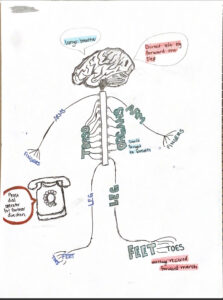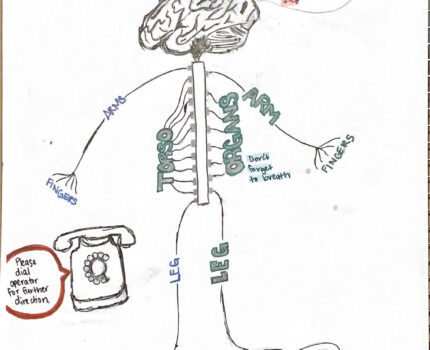 I decided to create a drawing, likening the CNS and PNS to an old school telephone operating system. I used the spinal cord as the switchboard of the telephone system. The operator is the brain. Then there are wires, like telephone lines down the street, that are the PNS. They take the message that the CNS specifically meant for the toes down to the toes. Or the message that was meant for the arms, to the arms.
I decided to create a drawing, likening the CNS and PNS to an old school telephone operating system. I used the spinal cord as the switchboard of the telephone system. The operator is the brain. Then there are wires, like telephone lines down the street, that are the PNS. They take the message that the CNS specifically meant for the toes down to the toes. Or the message that was meant for the arms, to the arms.


This portrayal of the Central and Peripheral Nervous Systems being a telephone switchboard successfully depicts its role as a telecommunication network. CNS’s brain and spinal cord does act as the control center, or in this case, the operator, as it integrates sensory input and dictates motor output. This system’s basic function is receiving information telling of the body’s internal and external conditions and making decisions on actions to maintain homeostasis and ensuring survival. As far as sending messages out, and sending impulses all the way to the ends of limbs goes, that’s where the PNS’s nerves and ganglia, or telephone lines, come in. Sensory neurons transmit impulses from sensory receptors that detect heat, cold and pressure towards CNS, motor neurons carry impulses away from CNS, and interneurons shuttle signals within CNS. Myelin sheaths help speed up nerve conduction, and appears white. The white matter is a good sign that the area is carrying information through quickly, whereas gray matter that can also found in the brain and spinal cord is unmyelinated and focuses more on information processing. Another function of the PNS is found in the Autonomic Nervous System that carries out the involuntary movements through CNS impulses sent to cardiac muscle, smooth muscle,and glands. This helps perform necessary subconscious actions like digestion, a heart beat, and as shown in the image, breathing. My favorite thing about this drawing was that it was easy to look at, and quick to understand exactly what it was trying to tell me.